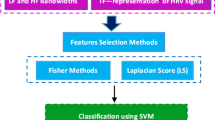Abstract
This article explores the possibility of using the higher-order spectra to identify different types of diseases. In order to assess the effectiveness of such tool the HRV (Heart Rate Variability) recordings obtained from patients suffering from three different cardiac problems are listed and compared to the results recorded for healthy subjects. Each set of HRV signals is processed with bispectral and bicoherent analysis. In both cases three statistical parameters are observed. For each type of the investigated analysis the parameters under examination differ enough to allow clear distinction of the specific cardiac disease. The obtained results show usefulness of higher-order spectra as a tool for differentiation between specific diseases. Authors believe that further work would greatly improve potential of the described tool, allowing to identify number of different diseases or even stage of the illness or progress in the rehabilitation process.
Access this chapter
Tax calculation will be finalised at checkout
Purchases are for personal use only
Similar content being viewed by others
References
Physionet. http://physionet.org/. Accessed 5 Mar 2015
Chua, K.C.: Analysis of cardiac and epileptic signals using higher order spectra. Ph.D. thesis, Queensland University of Technology (2010)
Gałąska, R.: Analiza fraktalna zmienności rytmu zatokowego u pacjentów z upośledzoną funkcją lewej komory mięśnia serwcowego. Ph.D. thesis, The Medical University of Gdańsk (2006). (in Polish)
Goshvarpour, A., Goshvarpour, A.: Comparison of higher order spectra in heart rate signals during two techniques of meditation: chi and kundalini meditation. Cogn. Neurodyn. 7(1), 39–46 (2012)
Hellwig, Z.: Elementy rachunku prawdopodobieństwa i statystyki matematycznej. Wydaw, Naukowe PWN (1995). (in Polish)
Jouny, I., Moses, R.: The bispectrum of complex signals: definitions and properties. IEEE Trans. Sig. Process. 40(11), 2833–2836 (1992)
Kłopocka, M., Budzyński, J., Bujak, R., Świątkowski Maciej and. Sinkiewicz, W., Ziółkowski, M.: Dobowa zmienność rytmu zatokowego serca jako wskaźnik aktywności autonomicznego układu nerwowego u mężczyzn z zespołem zależności alkoholowej w okresie abstynencji. Alkocholizm i Narkomania 13(4), 491–501 (2000). (in Polish)
Krauze, T., Guzik, P., Wysocki, H.: Zmienność rytmu serca: aspekty techniczne. Nowiny Lekarskie 70(9), 973–984 (2001). (in Polish)
Mazur, P., Matusik, P., Pfitzner, R.: Analiza parametrów częstotliwościowych zmienności rytmu serca po pomostowaniu aortalno-wieńcowym. Folia Cardiologica Excerpta 6(1), 76–81 (2011). (in Polish)
Mendel, J.: Tutorial on higher-order statistics (spectra) in signal processing and system theory: theoretical results and some applications. Proc. IEEE 79(3), 278–305 (1991)
Nikias, C., Mendel, J.: Signal processing with higher-order spectra. IEEE Sig. Process. Mag. 10(3), 10–37 (1993)
Pander, T.: Zastosowanie metod częstotliwościowych do wyznaczania przesunięcia sygnałów biomedycznych w dziedzinie czasu. Ph.D. thesis, Silesian University of Technology (1999). (in Polish)
Saliu, S., Birand, A., Kudaiberdieva, G.: Bispectral analysis of heart rate variability signal. In: 2002 11th European Signal Processing Conference, pp. 1–4 (2002)
Socha, L.: Równania momentów w stochastycznych układach dynamicznych. Wydaw. Naukowe PWN (1993). (in Polish)
Swami, A., Mendel, J.M., Nikias, C.L.M.: Higher-order spectral analysis toolbox: For use with MATLAB (1993). (User’s Guide)
Author information
Authors and Affiliations
Corresponding author
Editor information
Editors and Affiliations
Rights and permissions
Copyright information
© 2019 Springer International Publishing AG, part of Springer Nature
About this paper
Cite this paper
Tkacz, E., Budzianowski, Z., Oleksy, W., Tamulewicz, A. (2019). The Higher-Order Spectra (HOSA) as a Tool for the Rehabilitation Progress Estimation Referred to the Patients Diagnosed with Various Cardiac Diseases. In: Pietka, E., Badura, P., Kawa, J., Wieclawek, W. (eds) Information Technology in Biomedicine. ITIB 2018. Advances in Intelligent Systems and Computing, vol 762. Springer, Cham. https://doi.org/10.1007/978-3-319-91211-0_27
Download citation
DOI: https://doi.org/10.1007/978-3-319-91211-0_27
Published:
Publisher Name: Springer, Cham
Print ISBN: 978-3-319-91210-3
Online ISBN: 978-3-319-91211-0
eBook Packages: Intelligent Technologies and RoboticsIntelligent Technologies and Robotics (R0)




